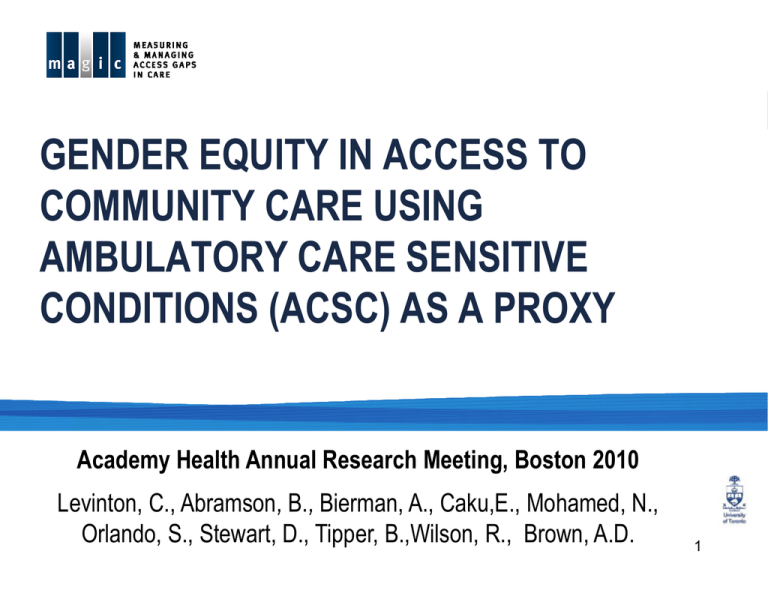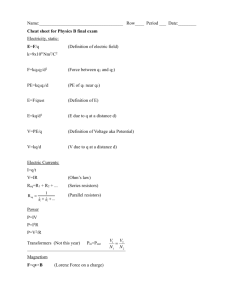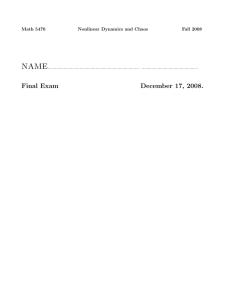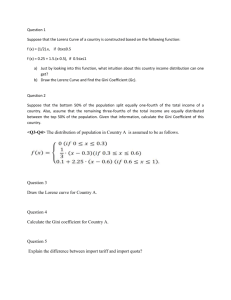GENDER EQUITY IN ACCESS TO COMMUNITY CARE USING AMBULATORY CARE SENSITIVE
advertisement

GENDER EQUITY IN ACCESS TO COMMUNITY CARE USING AMBULATORY CARE SENSITIVE CONDITIONS (ACSC) AS A PROXY Academy Health Annual Research Meeting, Boston 2010 Levinton, e o ,C C.,, Abramson, b a so , B.,, Bierman, e a , A.,, Ca Caku,E., u, , Mohamed, o a ed, N.,, Orlando, S., Stewart, D., Tipper, B.,Wilson, R., Brown, A.D. 1 Outline Research question Methods Databases and linkage Analytical method - equity model Results Discussion and implications for health policy 2 Research questions and Outcome of Interest Research Questions - To what extent do social factors contribute to inequities in access to community care beyond that which can be explained by clinical or health factors? - Are there differences in the patterns of inequity between men and women? • Outcome of interest: Hospitalization p for an ambulatoryy care sensitive condition (ACSC) - Hypertension, adult asthma, chronic obstructive pulmonary disorder, congestive ti hheartt ffailure, il diabetes, di b t depressive d i disorders, di d alcohol l h l andd ddrug psychoses, neurotic disorders, alcohol and drug dependence, non-dependent abuse of drugs 3 Databases 1 Hospital Person Oriented 1. Information (HPOI) - Administrative database of all acute inpatient separations in Canada (excluding Quebec) g p include: sex,, age, g , - Basic demographics postal code (region) - Fiscal years 92/93 to 04/05 (13 years) - Includes: diagnostic codes, codes surgical/procedure codes, accident codes, admission and separation dates - Mix of ICD-9 ICD 9 and ICD-10 ICD 10 coding (change over time) - Linkage variable: Health Insurance Number (HIN) 2 CCHS (Canadian Community 2. Health Survey) - Four ou cycles cyc es ((2001, 00 , 2003, 003, 2005, 005, 2007) 00 ) - ~ 130,000 respondents/cycle - Includes socio-economic and d demographic hi variables, i bl e.g.: age, sex, education, income level, general mental and physical health, work status, geographic region, etc. - Includes self-assessed mental and physical health status status, health service utilization, behavioral risk factors - Linkage variable: Health Insurance N b (HIN) Number 4 Analytical Method (Step 1- Use of CART) 5 Analytical Method (Step 2- Develop Lorenz Curves) Develop a Lorenz curve and resulting Gini coefficient to measure (in)equity among the sub-groups CART generates the vector of coefficients used to calculating the Gini coefficient, via i a LLorenz curve – a cumulative l ti measure off iinequality lit Rank order the groups identified by the CART algorithm from lowest to highest rates Plot the cumulative rates of ACSC vs. cumulative proportion of population The graph produced is the Lorenz curve 6 Equity model results : Examples of subgroups Variable Type Group 1 Group 2 Group 3 Group 4 Group 5 Group 6 Health + Socio-Economic Determinants (Health Very Good to Excellent Age < 50) Middle to High Income Employed (Health Very Good to Excellent Age < 50) Lower to Middle to Income Not Employed (Presence of Chronic Disease with Mild effect on Daily activities Age >= 50) Low Income (Health Good to Excellent Age >= > 50) Low Income (Health Poor to Average Age >= > 50) Working Part Time Household Size 2 or less Ethnicity-Non English (Health Poor to Average Age >= > 50) Working Part Time Household Size 3 or more Ethnicity-Non English ACSC rate %(N) 5.25(1,416,991) 13.96(259,426) 26.90(253,406) 34.96(374,411) 43.79(311,729) 61.06(202,574) 8.21 4.11 16.03 12.66 35.08 34.99 42.46 45.20 7.06(12.82) 10.24(14.16) 10.47(11.9 1) 20.47(35.3 6) 9.47(10.62) 10.99(12.38) 10.51(13.15) 18.23(37.70) 12.60(15.81) 13.82(18.07) 18.24(51.7 3) 16.42(17.6 5) 2.65(0.97) 2.85(0.97) 2.98(1.02) 3.16(0.96) 2.88(0.80) 3.09(0.85) 2.91(1.14) 2.89(1.12) 2.74(1.01) 2.57(0.90) 2.24(0.71) 3.19(0.98) Males (%) Females (%) Consultations With Medical Doctors M Mean(SD) F Availability of health care Services in Community y M F Mean(SD) 23.59 31.04 61.27 61.02 7 Results: Lorenz curves 1 Eastern Canada 0.9 0.8 Cumulative e Proportion o of Events Fem ale Males 0.7 06 0.6 0.5 0.4 0.3 0.2 0.1 0 0 0.2 0.4 0.6 Cumulative Proportion of the Population 0.8 1 8 Results: Lorenz curves 1 Eastern Canada 0.9 0.8 Cumulative e Proportion o of Events Fem ale Males 0.7 06 0.6 0.5 0.4 0.3 Gini = 0.375 ((0.335,, 0.419)) 0.2 0.1 0 0 0.2 0.4 0.6 Cumulative Proportion of the Population 0.8 1 9 Results: Lorenz curves 1 Eastern Canada 0.9 0.8 Cumulative e Proportion o of Events Fem ale Males 0.7 06 0.6 0.5 0.4 0.3 Gini= 0.525 (0 491 0.560) (0.491, 0 560) 0.2 0.1 0 0 0.2 0.4 0.6 Cumulative Proportion of the Population 0.8 1 10 Conclusion and Discussion Females demonstrate greater disparity in ACSC hospitalizations based on health or clinical variables. Lower L iincome, poor hhealth, lth andd ethnicity th i it may bbe contributing t ib ti ffactors t tto greater t inequity Implications p on the health care system: y Policies to reduce inequities q through g supporting improved access to high quality care in the community, focusing on identified groups with high rates of ACSC hospitalizations may lead to: Shorter ED wait times as a result of reduced need for ED utilization Alleviation of high bed occupancy rates especially in large urban centers Resulting decrease in health care costs with potentially lower cost community it care replacing l i hi higher h costt acute t care Healthier individuals with better managed conditions 11 Appendix 12 Definitions of Ambulatory Care S iti Sensitive Conditions 13 Generalized Lorenz Curve • Expressed as follows: v 1 G v v cov y, 1 F y y • = 2 reduces to standard Gini index • This “aversion” parameter simply permits weighting of different socio-economic groups. Larger values of applies less weight to “higher” socio-economic groups. 14 Results: Differences in ACSC rates for some SES variables SES Variable Marital Status Schooling Geography Males Females Married 0.222 0.132 Unmarried 0.214 0.214 < Secondary 0.312 0.237 Secondary graduate 0.134 0.169 S Some post-secondary t d 0 199 0.199 0 138 0.138 Post-secondary graduate 0.171 0.130 Urban 0 225 0.225 0 165 0.165 Rural 0.201 0.177 15 Results: Differences in ACSC rates for some household income SES Variable Household Income Level Males Females 10,000 – 19,999 0.250 0.244 20,000 – 29,999 0.286 0.180 30,000 – 39,999 0.235 0.233 40,000 – 49,999 0.229 0.104 50 000 – 59,999 50,000 59 999 0 360 0.360 0 133 0.133 60,000 – 79,999 0.168 0.076 80 000 and over 80,000 0 159 0.159 0 095 0.095 16 Results: Lorenz curves Western Canada Model includes health + social factors 17 Equity model results: Gini coefficients * Confidence Intervals at P < 0.05 Model consists of: ((1)) Health factors – age, g , ppresence of chronic disease,, health utilityy index,, mental health pphysical y health,, social support; pp ; (2) SES factors – education status, income (personal, household), barriers to health access, labor force participation, race, immigration status, language, marital status, geographic region. 18








